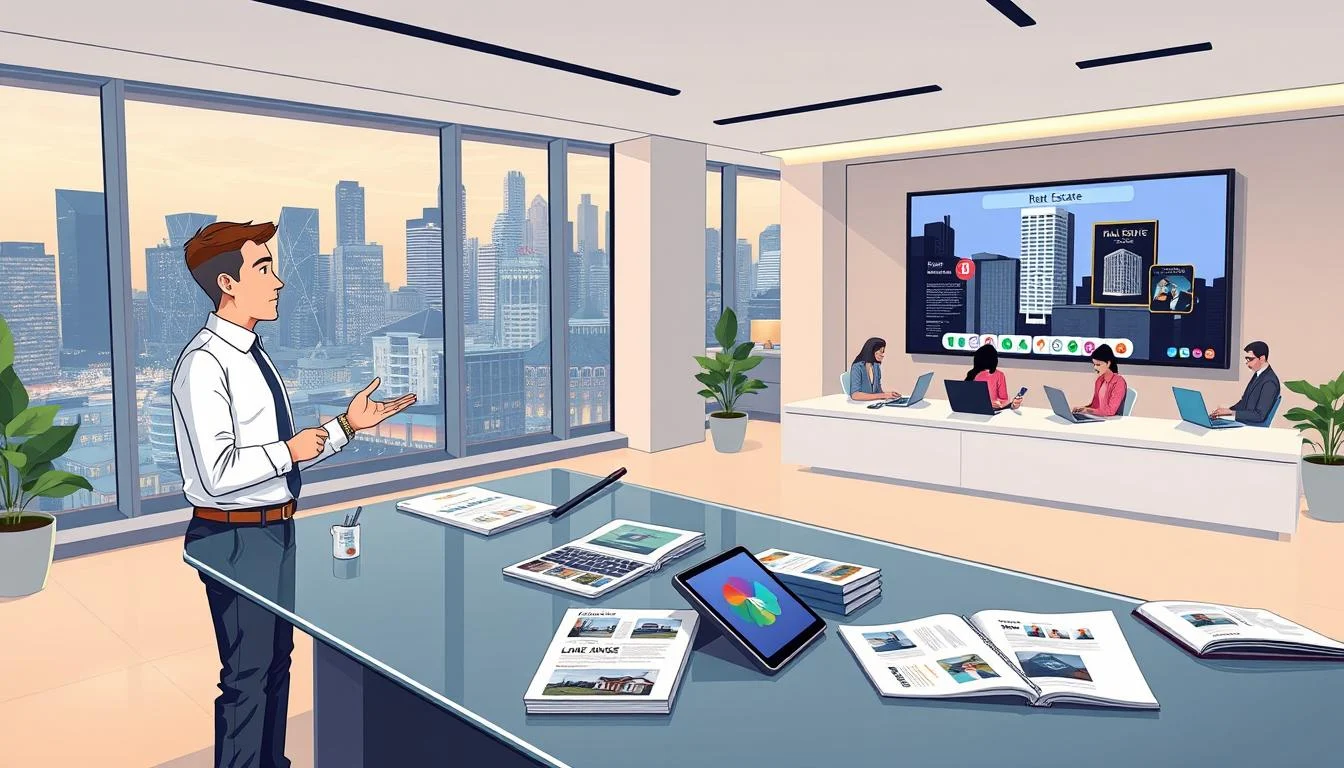Ever wondered why some properties sell fast while others take months? The secret might be simpler than you think. Real estate video marketing has changed how properties meet buyers in today’s digital world.
In the last decade, visual stories have become key for property pros. It’s no surprise that 80% of people watch online videos. But what’s striking is that half of them decide to buy after watching! The same is true for property sales.

Most home buyers see a property online first. Their first contact is often a property video. This could be a video of a home they like or a realtor they might want to work with.
As a real estate agent, using dynamic video content can really boost your listings. It can also bring in more qualified leads and help you close more deals. Properties with videos get an amazing 403% more interest than those without!
Ready to change how you market properties? Find a skilled video marketing freelancer. They can help you create engaging visual stories that connect with future clients.
Table of Contents
Key Takeaways
- Properties with videos receive 403% more inquiries than those without
- 80% of consumers watch online videos, with half being influenced to purchase
- Video has evolved from a luxury to an essential marketing tool in real estate
- Most prospective buyers first experience properties through online videos
- Effective video content works for both commercial and residential properties
- Visual storytelling creates emotional connections with future buyers
The Power of Video in Today’s Real Estate Market
Video content is key in today’s real estate market. It grabs buyers’ attention like nothing else. With screens everywhere, showing properties through video is now a must for agents.
Video tours offer a unique experience. They let buyers see a property’s vibe before visiting. This is super helpful in fast-paced markets where decisions are made quickly.
Why Video Converts More Leads Than Photos Alone
Video is faster to process than text. It shows properties in action, not just static images. This makes buyers feel like they’re exploring the space themselves.
Video connects emotionally with viewers. It shows how a property feels, not just what it looks like. This emotional connection is key in making buying decisions.
Videos build trust by showing everything about a property. This makes buyers feel confident in their choices. Serious buyers are more likely to request showings after watching videos.
Want to improve your listings with video? Hire a skilled real estate videographer to showcase properties in the best way.
Current Statistics That Prove Video Marketing ROI
Video marketing in real estate is a game-changer. Listings with videos get four times more interest than those without. Plus, homes with video sell 68% faster.
Here are some stats that show video’s power:
- Viewers remember 95% of a video message, but only 10% of text
- Video gets 1,200% more shares than text and images on social media
- Adding video to landing pages boosts conversion rates by up to 80%
- 86% of home shoppers use video to research properties
For agents, these numbers mean better marketing ROI. Investing in video leads to faster sales and more referrals. In today’s market, brand videos are a must for top agents.
Real Estate Video Marketing Services Explained
Professional real estate video marketing services turn simple property listings into engaging stories. This is key in a competitive market. Quality visual content can make a big difference in selling a property. Let’s look at what these services offer and when they’re worth it.

What Professional Video Services Include
Real estate video production services do more than just take pictures. They offer a full process to make your property stand out. This includes three main steps:
First, they assess your property, write scripts, and plan. They find what makes your property special and create a story around it.
Then, they start filming. They use top-notch equipment to get great footage. This is where their skill and attention to detail shine.
After filming, they edit the video. They add music, color, and graphics to make it look amazing. The end result is a video that showcases your property in the best way possible.
“When showing homes, video quality is very important. Sellers want it to look beautiful. Everything must be perfect. If I’m professional, my video should look professional too.”
Joe Siciliano, Compass
When to DIY vs. When to Hire Professionals
Not every video needs a pro. For quick social media posts or simple previews, you can DIY. Smartphones can make good videos for casual use.
But, for important listings, you need professionals. Quality videos attract better buyers and can sell faster. This investment can lead to more money.
Also, if you’re building your brand, professional videos are a must. They show your professionalism. Joe Siciliano from Compass says clients notice the quality.
For big marketing campaigns, professionals keep your brand consistent. If you want to improve your marketing, find experienced video specialists. They can make your listings into powerful stories.
The cost of professional services depends on the property, video length, and complexity. But, the benefits—faster sales and higher offers—make it a smart choice for serious agents.
Essential Equipment for Creating Quality Property Videos
To make top-notch property videos, you need the right tools. The gear you pick affects how buyers see your listings. Even beginners can make high-quality video with the right equipment.
Camera Options for Every Budget Level
You don’t need expensive gear for great real estate videos. A recent smartphone with a stabilizer (about $200-300) works well. It can record in 4K and has great image stabilization.
For better quality, consider DSLR or mirrorless cameras ($800-1,500). They offer better depth and handle low light well. You can change lenses for different shots, like wide interiors or detailed exteriors.
For high-end properties, go for cinema cameras ($2,500+). They give you cinematic quality and a wide range of colors. Choose a camera that matches your skill and the properties you show.
Lighting and Audio Equipment Essentials

Good lighting is key for quality video. Basic LED panel lights ($100-200) can make spaces look better by reducing shadows. For more options, get a three-point lighting kit.
Don’t overlook audio quality. Bad sound can ruin good video. Get a lavalier microphone ($50-100) for clear voiceovers and a portable recorder ($100+) for better ambient sounds.
Drone Technology for Stunning Aerial Footage
Aerial drone footage changes real estate marketing by adding new views. Entry-level drones (about $500) can record in 4K, perfect for most homes.
For pros, spend more on drones ($1,500+) for longer flights and better images. Always follow drone laws and get the right permits. Drone shots are great for showing off big properties, neighborhoods, or views.
Need help with property videos but don’t have the right gear or know-how? Find experienced videographers who can make your property look amazing and sell faster.
Developing Your Real Estate Video Marketing Strategy
Before you start filming, having a solid video marketing plan is key. A good plan makes sure your marketing efforts meet your goals and speak to your audience. Agents who plan their content do better than those who don’t.

Your content marketing plan should mix consistency with quality. This way, you build momentum without getting too tired. Joe Siciliano from Compass says, “Be real and connect with clients genuinely. Taking action now is more important than waiting for it to be perfect a month later. You’ll figure it out as you go.”
If planning feels too much, consider hiring a real estate video freelancer. They can create a strategy that fits your needs.
Setting Clear Objectives and KPIs
Every good marketing strategy starts with clear goals. Decide what you want to achieve with your videos. Do you want to get new leads, show off properties, or grow your brand?
After setting your goals, choose specific Key Performance Indicators (KPIs) to measure success. Just looking at view counts isn’t enough.
| Marketing Objective | Primary KPIs | Secondary KPIs |
|---|---|---|
| Lead Generation | Conversion Rate, Form Completions | Click-Through Rate, Comments |
| Property Showcase | Time Watched, Showing Requests | Social Shares, Watch Completion |
| Brand Building | Subscriber Growth, Engagement Rate | Audience Retention, Mentions |
| Client Education | Watch Time, Return Viewers | Questions Asked, Resource Downloads |
I check these metrics every month to improve my videos. This way, I know what my audience likes.
Identifying and Targeting Your Ideal Buyers
Knowing your target audience is key for making videos that work. I look at my past sales to find patterns in who buys what and why.
Think about these when defining your ideal buyer:
– Demographics (age, income, family status)
– Property preferences (size, style, amenities)
– Buying motivations (investment, lifestyle change, relocation)
– Online behavior (platforms used, content consumed)
This info helps me make videos that really talk to my audience. For example, I make videos for first-time buyers about money and education. Videos for luxury buyers focus on special features and investment.
Creating buyer personas has changed my marketing efforts for the better. Tailoring content to each group has boosted engagement and sales.
Remember, being real is more important than being perfect. As a real estate marketer, your personality and knowledge are what connect you with clients and properties.
Commercial Real Estate Video Techniques
Making effective commercial real estate videos is all about showing business value, not just emotions. Unlike homes, commercial spaces need to show their practical uses and investment chances. Good videos for these properties talk to business leaders, showing how they can help their bottom line.
Filming commercial places is different from homes. When it’s about office buildings, shops, or factories, focus on what investors and business owners care about. Let’s look at the key ways to make commercial real estate videos stand out.
Highlighting Business Amenities and Infrastructure
Amenities that help businesses run well are key. Use smooth camera moves to show off office layouts, meeting rooms, and team areas. Also, show off tech like fast internet, smart building tech, and security.
Today’s businesses want places that boost productivity and make employees happy. Show off:
- Advanced tech like server rooms and wiring
- Common areas and meeting spots
- Fitness rooms or wellness areas
- Cafeterias or food service spots
For luxury commercial properties, highlight top features like rooftop terraces, executive lounges, or concierge services. These can make your property stand out on the MLS and other sites.
Showcasing Location and Accessibility Features
Location is key for commercial real estate. Your videos should show how easy it is to get there by car, public transport, or on foot. Drone shots give a great view of a property’s location benefits.
Show how close it is to:
- Highways, airports, and public transport
- Nearby shops, restaurants, and parks
- Parking and loading zones
- Walking distance to other businesses
Many real estate companies use video to show location maps with animated overlays. This shows drive times to important places, helping buyers see how convenient it is for employees and clients.
Creating Investment-Focused Narrative Videos
Commercial property videos should tell a story about investment. Include market data, growth forecasts, and ROI calculations in a way that’s easy to watch. Show how the property can meet business needs or make money.
Include real testimonials from businesses that have done well there. These stories build trust and help investors see success. Use video interviews with local business leaders to add to your story.
Look at Escapade Living, a company that targets motorsports fans. Their videos mix modern interiors with racing footage. Drone shots of the racetrack nearby add excitement, speaking directly to their audience.
| Commercial Video Element | Purpose | Technique | Impact on Buyers |
|---|---|---|---|
| Infrastructure Showcase | Highlight operational capabilities | Detailed interior panning shots | Demonstrates practical functionality |
| Location Mapping | Emphasize accessibility | Aerial footage with graphic overlays | Visualizes convenience factors |
| Investment Narrative | Present business opportunity | Data visualization and testimonials | Builds financial confidence |
| Niche Targeting | Appeal to specific industries | Industry-specific footage integration | Creates immediate relevance |
If you want to improve your commercial property listings with professional video, consider hiring a skilled real estate video freelancer. They can help attract serious investors and business buyers.
Residential Property Video Approaches
Residential property videos have grown from simple walkthroughs to powerful storytelling tools. They sell lifestyles, not just houses. Today’s real estate marketers know that different video approaches can evoke emotions that photos can’t. By using video content wisely, agents can connect deeply with buyers and boost property interest.
Creating Emotional Connection Through Storytelling
The best listing videos tell a story that lets viewers imagine living there. Narrative-driven videos, like a “day in the life,” create strong emotional bonds. Imagine a family enjoying breakfast on a sunny patio or friends in an open kitchen.
These videos turn an empty house into a home by showing how spaces can be used. Use natural lighting, smooth transitions, and authentic moments. The goal is to let viewers see their own stories in those walls.
Virtual Tours That Feel Like In-Person Visits
Modern virtual tours change how buyers see properties from afar. Tools like Matterport and 360-degree cameras offer immersive walkthroughs that feel real. Viewers can explore at their pace and revisit favorite spots.

For effective virtual tours, keep the orientation and flow right. Use stabilization and plan your route for smooth room-to-room movement. Interactive hotspots with extra info can also enrich the experience.
Lifestyle Videos That Sell the Neighborhood
Some top marketing videos barely show the property. They focus on the lifestyle it offers. For example, a vineyard video might show rolling hills, cyclists, and kayakers, with the company logo subtly there.
These lifestyle videos sell the dream of living in a place. They highlight local amenities, schools, parks, and restaurants. They answer the question: “What would my life be like here?” Show seasonal activities and local events for maximum impact.
Ready to boost your property marketing with professional video? Connect with our expert real estate videographers. They create emotional, engaging stories that sell.
Step-by-Step Shooting Guide for Property Videos
Creating great real estate videos is more than just having good gear. It’s about following a proven process. Before I start filming, I plan out every shot and schedule for the best light. This is usually early morning or late afternoon, when the light is warm and inviting.
Planning is key for a successful video tour. I walk through the property first to note the best features. Then, I plan my shots to flow smoothly, guiding viewers through the space.

Composition Techniques That Enhance Spaces
Good composition can make any space look bigger and more appealing. I shoot from corners at chest height, not eye level. This makes rooms seem more spacious, which is great for small areas like bedrooms and bathrooms.
The rule of thirds helps create dynamic shots. I place important features along these lines for more engaging videos. Leading lines, like hallways or countertops, also draw the viewer’s eye through the space. Lighting is critical in real estate photography. I balance natural and interior light to avoid harsh shadows. Portable LED panels can brighten dark areas without looking fake.
Creating Smooth Movement and Flow Between Rooms
Smooth camera movement is essential for professional videos. I use a gimbal stabilizer for smooth shots that don’t shake. The “two-step” method helps transition between rooms smoothly.
When moving between rooms, I use slow panning shots. This lets viewers take in details. I also use slow-motion entry shots to create a “wow” moment, just like professional videographers do.
For extra impact, I use short “boomerang” clips. These are five seconds or less and make videos more interesting and fast-loading online. These techniques make the property tour flow well from one space to the next.
| Camera Movement | Best Used For | Equipment Needed | Effect Created |
|---|---|---|---|
| Slow Pan | Revealing views, large rooms | Tripod with fluid head | Elegance, spaciousness |
| Steady Walk-through | Room-to-room transitions | Gimbal stabilizer | Natural exploration |
| Slow-Motion Entry | First impressions, grand spaces | Camera with high frame rate | Dramatic reveal, awe |
| Aerial Descent | Property exteriors, context | Drone | Scale, neighborhood context |
| Detail Push-In | Premium features, finishes | Slider or gimbal | Emphasis on quality details |
Post-Production Tips for Professional-Looking Videos
Post-production turns simple recordings into professional marketing assets. This process can make any footage look polished and appealing. Learning a few key techniques can greatly improve your real estate videos, even if you’re new to editing.
Editing lets you control the pace, highlight important features, and connect with viewers emotionally. With the right approach, you can make ordinary footage into compelling visual stories. These stories can motivate viewers to see the property in person.
Editing Software Options for Different Skill Levels
Choosing the right video editing software depends on your comfort level and budget. Beginners can use free options like iMovie (Mac) and DaVinci Resolve Free. These platforms are easy to use and have powerful features.
For those who need more, Adobe Premiere Elements ($99) and Final Cut Pro ($299) offer advanced features. They are great for agents who make videos often. These programs are easy to use but also professional.

For advanced editing, Adobe Premiere Pro (subscription-based) and Avid Media Composer are top choices. They have tools used by professionals. These programs are perfect for complex projects.
Color Grading to Enhance Property Appeal
Color grading is key in post-production for real estate videos. Start by fixing white balance issues. Most software has tools to help with this.
To make spaces look brighter, adjust contrast. A slight increase in saturation can make colors stand out. Consistent color tones make properties look well-maintained and inviting.
For interior shots, warm the color temperature slightly. This creates a cozy atmosphere that makes viewers imagine living there.
Adding Music, Graphics, and Voice-overs
The right music sets the mood for your video. Sites like Epidemic Sound and Artlist have royalty-free music. Choose elegant piano or orchestral pieces for luxury properties, and contemporary tracks for modern homes.
Clean, branded graphics add professionalism. Use simple lower-thirds to highlight property features and your contact info. Text should be minimal and stay on screen long enough to read.
For voice-overs, record in a quiet room. As real estate agent Joe Siciliano from Compass advises,
“Consistency is key. Commit to your schedule—whether it’s one video a week or a month—and stick to it. Over time, your audience will value your insights and remember you when they’re ready to buy or sell.”
If you want to improve your videos without learning everything, consider professional video editing services. They can turn your footage into cinematic content that stands out in the market.
Maximizing Video Distribution and Exposure
Even the most impressive property videos won’t generate leads if they aren’t shared across the right platforms. Creating compelling real estate videos is just half the equation. Knowing where and how to share them effectively completes your marketing strategy. Let’s explore how to maximize your video’s reach and impact across various digital platforms.

The key to successful distribution lies in understanding each platform’s unique strengths and audience expectations. With the right approach, your property videos can dramatically increase engagement, lead generation, and ultimately, sales conversions.
Platform-Specific Strategies (YouTube, Instagram, TikTok)
Each social media channel requires a tailored approach to maximize engagement. For YouTube, focus on SEO-optimized titles, descriptions, and tags. Create longer, more detailed property tours and neighborhood guides.
Instagram demands visually stunning, shorter content. Use Instagram Reels for quick property highlights, Stories for behind-the-scenes glimpses, and IGTV for more detailed tours. Include location tags and relevant hashtags to increase discoverability.
TikTok thrives on creativity and trends. Create 15-60 second clips showing unique property features or before-and-after renovations. Participate in trending challenges by adapting them to showcase properties. The algorithm favors authentic, entertaining content that keeps viewers watching until the end.
Integrating Videos into Listings and Websites
Embedding videos directly into your property listings creates a seamless experience for buyers. When allowed by your MLS, include video tours prominently in listings. This significantly increases engagement and time spent viewing your properties.
On your website, create dedicated landing pages for featured properties with embedded videos. Place video thumbnails above the fold to encourage immediate viewing. Optimize page load times by using compressed video formats that don’t sacrifice quality.
Consider adding a video gallery section to showcase your entire portfolio. Organize it by property type or neighborhood. This enhances your online presence and positions your real estate business as modern and client-focused.
Email and Messaging Campaigns with Video Content
Email remains one of the most effective channels for nurturing leads, and adding video dramatically increases engagement. Including the word “video” in your subject line can boost open rates by up to 19%. Use animated thumbnails or video preview images to entice recipients to click.
Create targeted email campaigns featuring different video types. Include new listing announcements, neighborhood spotlights, client testimonials, or market updates. Segment your audience to ensure the content is relevant to each recipient’s interests and buying stage.
For direct messaging, personalized video messages can create a powerful connection. A brief, personalized walkthrough addressing a client’s specific questions about a property can be the difference between scheduling a showing or losing interest. These personal touches help build trust and demonstrate your commitment to client service.
Measuring and Improving Your Video Marketing Results
Tracking the right metrics for your real estate videos makes them powerful tools for growth. Without tracking, you’re flying blind in a tough real estate market. Agents who check their video stats often do better at turning viewers into clients.
Counting views alone is outdated. Today’s top agents measure success in a smarter way that fits their marketing strategy. Let’s dive into how to measure and boost your video marketing.
Essential Metrics to Track for Real Estate Videos
When checking your brand videos, focus on these key areas:
- Engagement Metrics: Look at average view time and watch time to see if your content grabs attention. Note where viewers lose interest to improve.
- Conversion Metrics: Track clicks to listings, form submissions, and showings from video views. These show how your videos lead to business results.
- Audience Metrics: Know who’s watching and how they see your content with demographic and location data.
Use tools like YouTube Studio and Facebook Insights to track your videos. Combine these with your website analytics to see the whole path from view to client.
Using Analytics to Refine Your Approach
Analytics are most valuable when you use them to better your marketing efforts. Do monthly reviews to spot trends in your top videos. What content works best for whom? When do you get the most engagement?
“You’re never going to compete with Realtor.com from a sheer number of views—but don’t try to be all things to all people. Agents use their website to showcase their team, philosophy, video testimonials, and thought leadership.”
Joe Siciliano, Compass
Joe Siciliano’s advice is key—aim for quality engagement with your audience, not just numbers. The 2024 NAR Profile shows sellers want agents to show properties on websites, making your videos key to your online presence.
Use analytics to try new video styles, lengths, and calls-to-action. For example, if viewers drop off at 60 seconds, make shorter videos. If certain areas get more interest, make more content for those places. A video marketing freelancer can help you make smart changes based on data.
Don’t forget to optimize your video content for SEO. Good titles, descriptions, and tags help people find your videos. Check these regularly to make sure your videos show up when people search for properties like yours.
Working with Professional Real Estate Video Marketing Services
Real estate pros looking to boost their marketing should think about working with video production teams. DIY videos are okay, but pros offer skills, creativity, and quality that speaks volumes. This makes a big difference to buyers and sellers.
As Compass agent Joe Siciliano says,
“When showing homes, video quality is key. Sellers want it to look stunning with great lighting. My video needs to look as professional as I am.”
This shows why many top agents see professional real estate video as a must-have for growing their business and reputation.
Finding the Right Production Partner for Your Needs
Finding the right video partner is more than just looking at prices. Start by checking their real estate portfolios. Look for properties like yours. They should know about architectural videography and property storytelling.
Read what other real estate professionals say about them. Ask about their gear and experience with your property types. This could be luxury homes, commercial spaces, or apartments.
While cost is important, remember that quality shows. Choose quality over saving money for your brand and the property.
What to Expect During the Production Process
After picking a partner, know what to expect. It starts with a creative talk about your property and goals. This is where you plan the story and script.
Then, there’s planning and getting ready for filming. Some services help with staging or props to make it look better.
On filming day, the crew will take lots of shots from different angles. They use special gear for smooth moves and great lighting.
After filming, the magic happens in post-production. This is where they edit, add music, and graphics. You’ll get to see it and make changes before it’s done.
Ready to elevate your property marketing? Click here to connect with experienced real estate video professionals who can showcase your properties at their best.
Conclusion
Video marketing has changed the real estate game. Properties with videos get 403% more inquiries and sell up to 68% faster. For realtors and agents, using video is now a must in the digital world.
We’ve covered the basics to advanced techniques in this guide. Whether it’s commercial or residential, video lets buyers see themselves in the space. It’s more than just pictures.
Video marketing tells stories that connect buyers with properties. They can imagine sunlight or their morning coffee on a patio. This creates a bond that photos can’t match.
Frequently Asked Questions
Got more questions about “Real Estate Video Marketing: Commercial and Residential”? I’m here to help! I’ve gathered some of the most common inquiries to provide you with quick and clear answers.
Q: How can luxury property be showcased effectively through video marketing?
A: Luxury properties require special attention to detail in video marketing. High-quality cinematography that highlights premium features, strategic lighting, and sophisticated editing are essential. Drone videos can capture sprawling estates and stunning landscapes, while slow-motion sequences emphasize elegant details. The best real estate videos for luxury properties often include lifestyle elements that help potential buyers envision themselves living there. Creating video content for luxury properties should focus on exclusivity, craftsmanship, and the unique selling points that justify the premium price point. Professional video production teams with a track record in luxury real estate can create cinematic videos that convey the true value of these exceptional properties.
Q: What are the essential elements of effective video production for real estate marketing?
A: Effective real estate video production combines several key elements: professional equipment, strategic planning, skilled videography, and polished editing. The process should begin with a clear marketing strategy that identifies the target audience and unique selling points of the property. High-resolution cameras, proper lighting, stabilization equipment, and potentially drone video capabilities are technical necessities.
The filming should include a comprehensive walkthrough of the property, highlighting key areas of the property that will appeal to potential buyers. Post-production editing should create a narrative flow, include appropriate music, color correction, and possibly graphics or text overlays that enhance marketing materials. The final video assets should be optimized for different platforms, whether it’s for MLS listings, social media content, or the realtor’s website.
Q: How can a real estate agent leverage video marketing to stand out from competitors?
A: A real estate agent can differentiate themselves by creating consistent, high-quality video content that showcases both properties and their personal brand. Beyond standard property tours, agents can produce market update videos, neighborhood guides, client testimonials, and educational content about the buying or selling process. This variety demonstrates expertise and helps build trust with potential clients. Developing a recognizable style or format for videos strengthens brand presence.
Agents should also leverage various platforms – from YouTube to Instagram Reels to Facebook – to maximize reach. Creating video content that provides genuine value to viewers, rather than just sales pitches, will establish the agent as a trusted advisor. Finally, tracking engagement metrics can help agents refine their video marketing strategy over time for optimal results.
Q: What video editing services are most valuable for real estate marketing?
A: The most valuable video editing services for real estate marketing include color grading to enhance visual appeal, smooth transitions between scenes, addition of compelling music, professional text overlays for property details, and removal of any distracting elements. Advanced services might include virtual staging of empty properties, day-to-dusk editing to show properties at the most flattering time of day, or composite shots that combine multiple frames for perfect exterior views.
Professional video editing services should also optimize videos for different platforms, create attention-grabbing intros, and produce various cuts of different lengths to serve different marketing purposes. For luxury properties, more sophisticated editing techniques like aerial shot integration, cinematic transitions, and detailed color correction can significantly elevate the final product, helping real estate businesses achieve a best-in-class video presentation.
Q: How can 360-degree videos enhance real estate property marketing?
A: 360-degree videos transform real estate marketing by offering potential buyers an immersive, self-directed tour experience. This type of video allows viewers to control their perspective, exploring spaces at their own pace and focusing on areas that interest them most. This interactivity creates a stronger connection to the property than traditional videos. For out-of-town buyers, 360-degree tours provide a comprehensive understanding of the layout and flow that’s nearly impossible to convey through photos or standard videos.
They’re particularly effective for showcasing open-concept spaces, unique architectural features, and panoramic views. These videos also signal that a realtor is using cutting-edge technology, potentially attracting more tech-savvy clients. When integrated with virtual reality headsets, 360-degree property tours can create an even more compelling experience that helps buyers feel as if they’re physically present in the space.
Q: What are the best practices for drone video in real estate marketing?
A: Drone videos have become essential in real estate marketing, particularly for showcasing larger properties. Best practices include obtaining proper licensing and permits for commercial drone operation, planning shots in advance to highlight property boundaries, neighborhood amenities, and proximity to landmarks. Weather and lighting conditions are crucial—early morning or “golden hour” often provides the most flattering natural light.
Professional drone operators understand how to capture smooth, stable footage with cinematic movements like slow reveals and gentle orbits around the property. For residential properties, aerial shots should emphasize lot size, landscaping, outdoor amenities, and surrounding views. For commercial real estate, drone videos can effectively illustrate traffic patterns, parking availability, and neighboring businesses. Always prioritize safety and privacy considerations when planning and executing drone video projects for real estate marketing.
Q: How can content marketing with videos help real estate companies improve their SEO?
A: Video content significantly boosts real estate SEO when properly optimized. Search engines favor websites with video content, often ranking them higher in search results. To maximize this benefit, real estate companies should host videos on their own websites while also posting to YouTube with backlinks. Videos should have keyword-rich titles, descriptions, and tags that include location-specific terms and property features. Transcribing video content adds searchable text that helps search engines understand and index the content. Creating topic-specific videos that answer common buyer questions can help capture long-tail keyword searches.
Property tour videos, market updates, and neighborhood guides all provide opportunities to incorporate relevant keywords naturally. Additionally, videos increase time spent on site and reduce bounce rates—metrics that positively influence search rankings. A consistent video publishing schedule signals to search engines that the website provides fresh, relevant content, further improving SEO performance.
Q: What additional services should be included in a comprehensive real estate video marketing package?
A: A comprehensive real estate video marketing package should include services beyond just filming and editing. Strategic consultation to determine the most effective type of video for specific properties and target audiences is essential. Professional scriptwriting ensures clear messaging that highlights key selling points. Distribution strategy services help maximize visibility across platforms including MLS, social media, email campaigns, and property websites.
Some providers offer aerial photography to complement drone video footage. Photography services create consistent visual assets for cross-platform marketing. Social media optimization ensures videos are formatted correctly for each platform. Analytics and reporting help track performance and ROI. For larger real estate businesses, some providers offer subscription packages with regular content creation. Additional services might include virtual staging, 3D rendering for pre-construction properties, or custom graphics and animations that enhance the creation process and final product.
Related Articles:
- How Much do Video Ads Pay and How Much Ad Revenue Can You Generate 2025?
- How Long Should a Social Media Video Be on Different Platforms? Optimal Video Length for Social Media
- How Much Does it Cost to do a Music Video? Understanding Music Video Costs in a Budget
- How to Make Slideshow Videos? Slideshow Maker for Stunning Videos
- Book Trailer Service: Ultimate Guide to Book Marketing & Book Trailer Production
This post contains affiliate links, which means I may earn a commission if you make a purchase through these links. There is no additional charge to you! Thank you for supporting my blog so I can continue creating free content each week!





